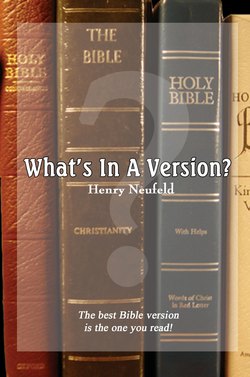Читать книгу What's in a Version? - Henry E. Neufeld - Страница 4
На сайте Литреса книга снята с продажи.
ОглавлениеIntroduction
The Bible is the most translated work in history. Many thousands of experts work on its translation year after year as they have been for centuries. Why is it then that there are such differences between one translation and another and such disagreement as to which translation one should use? Is it that difficult to determine what the Bible actually says and then just say it in English, or whatever language one is translating into?
The answer to these questions can be found in the nature of the Bible, how it was composed, how it was transmitted, and how translators go about expressing its meaning in a language other than the one in which it was written.
A number of factors make translations different. These include the source language manuscripts that the translators use, the people who translate and their intent, the method of translation, and the audience for whom they translate. There are many individual decisions that go into each of these elements, but the average reader may not even notice. These include capitalization, use of language related to gender, converting weights and measures, punctuation and section headings, amongst others.
I’m going to examine these from the layperson’s point of view, always asking how these difference change the way you use the Bible, whether in public reading or private, orally or silently, in worship or in a study group.
As a guide to help you find the information you want in this book, here are the chapter headings and a brief description of the contents.
1. What Goes into a Bible Version?
An overview of the translation process, looking at what goes into a Bible version. The next several chapters will go into greater detail about this short explanation. Some will want to just read this chapter and then go on to the list of Bible versions at the end.
2. The Biblical Text
This chapter starts with how the Bible was written including some notes on inspiration, then goes on to discuss how it was copied and preserved. One important aspect of a modern version is the text used. How can we be as certain as possible that we are looking at a translation of what the apostles and prophets wrote?
3. Translators
Who does the work of translation? I’ll discuss translators, their qualifications, their faith and motivations and even their character. How does all this impact the translation you hold in your hands?
4. Translation Methods
How do translators approach the text? Why can't they just translate it word for word into English without changing things? What constitutes a “change” rather than an accurate translation?
5. Receptor Language and Audience
What choices must be made concerning the language into which the Bible will be translated? Should the language be elevated and spiritual? Should it be easily understood? Should it be colloquial? We’ll discuss children’s Bibles, Bibles intended for evangelism, for those who speak English as a second language, for seasoned churchgoers, and other groups.
6. Special Characteristics
What other issues are involved in translation methods? This chapter discusses issues such as capitalization of pronouns referring to God and to Jesus, translation of cultural concepts, Biblical names, use of and designation of the divine name in the Old Testament and other issues.
7. Choosing a Bible
What factors go into the choice of a Bible to use? Should I use one Bible or several? Should a different Bible be used for reading and for more serious study?
8. Notes on Modern Translations
Brief reviews of the most popular translations. What are they each designed for and how well do they fulfill that role. Each review is on a formatted chart so you can quickly compare the types of differences that interest you.
Greek and Hebrew Texts
I have transliterated these texts very loosely with hopefully enough aids for English speakers to pronounce them in a reasonable way. This book is not intended for students of Biblical languages, so I will not provide a transliteration table, nor do the transliterations take account of all the details of the language. For the most part, transliterated Greek and Hebrew texts are used simply to help demonstrate the most literal translation.
